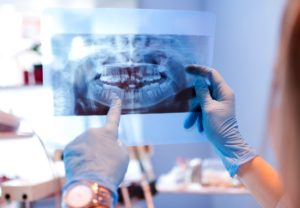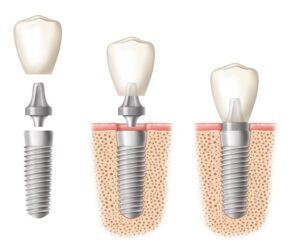Header logo
header top contact widget
Tooth Replacement
“Futuristic” Technology Surrounds Patient Care
Posted on Jul 30, 2020 by William J. Claiborne, DDS MS
Many adults are unfamiliar with the specialized skills of a periodontist – until they need one.
At Biltmore Periodontics in Asheville, most patients are referred by their general dentist or other dental specialist. However, a professional referral is not required. We accept patients from the recommendations of other patients as well as those who find us through internet searches, etc.
To clarify what we are and what we offer, a periodontist is a dentist who extends his or her education and skills further (typically 3 years past completing dental school) to specialize in the prevention, diagnosis, and treatment of periodontal disease and other gum conditions.
Additionally, a periodontal specialist has advanced skills in the diagnosis and placement of dental implants. A periodontal specialist is also trained in performing esthetic procedures that involve gum tissues, such as crown lengthening and correcting a “gummy smile”.
A periodontist’s office may have a similar look and feel of your general dentist’s office. However, the advanced skills and techniques are typically supported by advanced technology. Some offices, as ours (serving Western North Carolina) provide a rather “futuristic” array of technology to enhance treatment outcomes, save the patient time in treatment, speed healing time, and optimize comfort throughout care.
Periodontists are able treat complex periodontal cases of severe gum disease or caring for patients who have complex medical histories or health issues. They offer a wide range of treatments using a range of surgical or non-surgical procedures.
A periodontal office is also attuned to caring for high-fear patients. Periodontists understand that many people who develop periodontal (gum) disease do so because they were too afraid of dental treatment to see a dentist on a regular basis. Without a solid combination of thorough at-home oral hygiene and regular dental check-ups and cleanings, the potential to develop gum disease greatly increases.
In a recent report by the Centers for Disease Control & Prevention (CDC) on data related to prevalence of periodontitis in the U.S.: 47.2 percent of adults 30 years and older have some form of periodontal disease. Periodontal disease rates increase with age, affecting 70.1 percent for adults 65 years and older.
One study, published by StudyFinds.org, shares recent findings of 2,000 adults in the U.S. regarding dental visits. Results show a whopping 62 percent of those surveyed stating they were too afraid to even visit a dentist’s office. (https://www.studyfinds.org/adults-too-scared-visit-dentist-teeth/)
Surprisingly, the age group most likely to avoid dental care because of fear were millennials (currently ages 22 – 38). With past decades of advancements in comfort and greater sensitivity surrounding anxiety and fear in the dental office (versus what older generations often experienced), their higher levels of avoidance due to fear was unexpected, but clearly significant.
In our Asheville periodontal dental office, we provide special measures to ensure the safety and comfort of all patients – for every appointment. For many patients, Dr. Claiborne and Dr. Boyland offer Oral and I.V. Sedation. Sometimes referred to as “twilight sleep,” I.V. Sedation allows patients to be totally relaxed before, during and after treatment with little or no memory of the procedure.
Our periodontists also offer Oral Sedation in pill form to give a high level of relaxation, which typically has an amnesiac effect on patients. Throughout any type of sedation, patients are closely monitored by trained professionals and advanced safety equipment.
When it comes to technology, however, Biltmore Periodontics prides itself on some of the most advanced features available in the Southeast. These include:
• LANAP Protocol Using PerioLase MVP-7 – An acronym for Laser-Assisted New Attachment Procedure, LANAP provides an advanced protocol to more efficiently and effectively treat periodontitis (advanced gum disease) with a laser. This offers a minimally invasive (non-surgical) treatment alternative for patients with moderate to severe periodontal disease in as little as one session. It is safe for people with conditions such as diabetes, heart disease, and hemophilia. LANAP treatment leaves very little discomfort and has a quick recovery time.
LANAP technology is also able to stimulate bone regrowth in damaged areas. It can regrow periodontal ligament, alveolar bone (the bony ridge that supports the upper teeth), and regrow the bony film that adheres teeth to the jaw.
• Dental Radiology With 3-D Cone Beam Technology – Using 3D imaging for diagnostic and treatment planning, the entire dentition area provides clear, detailed views of the mandible and maxilla (upper and lower jaw) for precision diagnosis in endodontics (tooth roots), periodontics, orthodontics, dental implants, temporomandibular joints (TMJ) and prosthodontics as well as dental and maxillofacial surgery.
In addition, cone beam images can locate and trace the mandibular nerve canal, which optimizes pre-surgical planning of dental implant positioning.
Radiation levels are at minute levels and the imaging process is quick and comfortable.
• CareStream Cone Beam Computer Tomography Imaging – This technology provides panoramic and 3D imaging with exceptional detail and range at significantly lower radiation – up to an 85 percent lower dose than traditional panoramic imaging.
• CS 3600 intraoral scanner – Unlike impressions made with bulky, goopy trays held in a patient’s mouth, this modern scanner quickly and comfortably scans the mouth’s interior to provide digital impressions accurately. The device is a small, handheld scanner and ideal for impressions to design crowns, inlays, onlays, bridges, orthodontic appliances and aligners, custom abutments and RPD. Its accurate HD 3D color images give precision details for improved case review, analysis and communication between doctors, referrals and labs.
• Simplant Dental Software for Computerized Dental Implant Placement - This advanced software system allows for pre-surgical positioning of dental implants on the computer using a 3D model of the patient’s jaw. Once the implant type is selected, a surgical template is developed that ensures a precision fit. Simplant creates optimal implant treatment success, even for complex cases. It also simplifies the team treatment process so intricate aspects of the surgical process can be discussed prior to placement.
• Intraoral Camera Technology – This self-contained intraoral camera features full motion video with outstanding image quality from an internal camera that captures ideal angles and images with the click of a button. The images are sent to screen for a clear, crisp view so we can confer with patients on specific treatment issues.
• Computer Imaging In Treatment Suites – Treatment suites are equipped with computers for convenient image sharing with patients. This allows patients to have a more complete understanding of their individual needs through images that can be pulled up by our dental team, with the ability to enlarge certain areas to show specific details. Through this, patients have greater involvement in treatment decisions.
This extensive array of technology is in keeping with our commitment to provide each patient with advanced skills, experience and comfort to provide the very best in periodontal and dental implant treatment. Added to this is the truly talented, committed staff who tend to our patients in a warm, compassionate and respectful manner.
Overcoming gum disease can help patients to save natural teeth. This means the trauma of tooth loss and decisions for replacement can be avoided.
If you suffer with symptoms of gum disease (tender gums that bleed when brushing, persistent bad breath, or gums that have turned red in color), the condition will only worsen without treatment. Call our friendly staff to discuss your needs: 828-274-9440.
Considering Dental Implants? Why A Specialist Should Be Your Choice.
Posted on Jun 22, 2020 by William J. Claiborne, DDS MS
With added safety precautions and appointment protocols, our Asheville periodontal dental office has resumed a full schedule. And, we are busy!
In spite of the challenges surrounding a global pandemic, people are still in need of treatment for gum disease. Especially now. Gum disease is an inflammatory disease that is an added burden to the immune system. Because our immune systems need to be operating at peak levels to fight infection, healthy gums are being given renewed recognition.
As a periodontist, I also specialize in the diagnosis and placement of dental implants. We continue to provide this much needed option to patients in need of replacing teeth. After all, regardless of the challenges people face, they still need to be able to bite, chew, and speak.
When it comes to a partial or bridge to replace teeth, a patient faces future risks. Because a partial or bridge rely on adjacent teeth for support, the natural tooth (teeth) that serve to support these appliances bring on a significant challenge.
These dental prosthetics place added pressure and stress to the supporting natural teeth. Thus, there is a greater potential for damage to the structure of the natural teeth. This places those “crowned” teeth at risk for being the next to be lost.
Americans are coming to know that a denture creates a great many challenges. One of the most common complaints has to do with dentures that begin to move or ‘slip’ when eating or even speaking. This is due to bone loss that is occurring under the denture.
Without stimulation to the jaw bone where tooth roots were once supported, the bone begins to shrink. This is known as resorption. As resorption continues, the denture that was designed to the unique shape and height of this gum-covered ‘arch’ no longer provides a snug fit.
Because of this, denture wearers come to rely on denture adhesives and pastes. However, over time even frequent applications of these products are of little help. Relines, another option, can be done to reshape the denture’s base to conform to the shrinking arch. Eventually, even relines provide minimal improvement.
Bone loss also shows up in facial appearance. As the bone structures that give our face its shape start to shrink, deep wrinkles form around the mouth. Eventually, the corners of the mouth will turn downward, even when smiling. Jowls form on each side of the face as facial muscles detach from the declining bone structure.
As the jaw bone continues to shrink, the chin becomes more pointed and the nose seems to move closer to it. This leads to a collapsed mouth, sometimes referred to as a ‘granny look.’ This look ages the appearance of an individual that is far beyond their actual years.
However, the greatest challenge is when eating becomes a struggle. Because of movement and resulting sore spots on tender gum tissues, foods that require biting and rigorous chewing are often set aside for softer foods that dissolve quickly in the mouth.
Unfortunately, these food choices often offer less-than-ideal nutritional benefits, and typically very little fiber. It’s no wonder that denture wearers tend to have more gastrointestinal problems than people who are able to chew sufficiently and comfortably.
To me, what is especially troubling for long-time denture wearers is the avoidance of social gatherings. Studies have shown that being socially involved helps adults be more active both physically and mentally.
In a February 2019 article, Science Daily shared, “Researchers at The University of Texas at Austin have found that older adults who spend more time interacting with a wide range of people were more likely to be physically active and had greater emotional well-being.” (https://www.sciencedaily.com/releases/2019/02/190220074610.htm)
When adults fear embarrassing slips, clicks, or uncomfortable food pieces that become trapped between the gums and denture, declining social invitations becomes more and more frequent. Since many social gatherings include food or are centered around meals, denture-wearing adults have difficult choices to make. Go and hope for the best or risk an embarrassing moment?
As dental implants have become a more practical and popular option, adults are turning away from dentures, partials, or bridges. In addition to restoring biting and chewing comfort and stability, implants offer a lifetime replacement option that actually enhances the well-being and lifespan of surrounding teeth.
In dental implant treatment, the ‘implanted’ portion is positioned into the jaw bone as a tooth root replacement. This provides the attached teeth the same foundation as natural tooth roots have. This also recreates stimulation to the bone, halting the process of bone loss.
So, why should you search out a periodontist for your dental implant treatment? With so many one-stop clinics and online implant “special price today only!”, is the care of a periodontal specialist really needed?
Below are some reasons to consider how your dental implant treatment begins. Because, in the long run, it is a significant factor in the end result.
• Proper diagnosis: A periodontal specialist has advanced training to properly diagnose and place the most appropriate dental implant system for your needs and goals.
• Appropriate treatment: I have a reputation for never over-treating or under-treating. We structure treatment to provide the most successful outcome based on each patient’s unique needs by the most conservative means possible. Thus, the patient avoid having more time and expense than is necessary.
• Proper tools & equipment: As a periodontal office, we are fully prepared for the diagnosis and treatment of all stages of gum disease as well as the placement of dental implants. As such, we can tend to our patients in an efficient and effective manner. This also enables us to provide treatment in minimal time and to an exceptional level of comfort.
• Advanced features: In addition to trust, one of the reasons we receive so many referrals from physicians, dentists, and past/present patients has to do with the advanced technology and features we provide. We are also known for providing a high level of patient comfort through the administration of IV sedation (twilight sleep) with our on-site Board Certified Anesthesiologist. Additionally, diagnosis and treatment planning is backed by images from our on-site 3D Cone Beam technology.
• A respectful environment: We treat each patient with the same respect, compassion and gentle hands that we would want for ourselves and our loved ones. We take great pride in knowing our patients experience the finest periodontal and implant care available in the Southeastern United States.
Because of their ability to restore the presence of natural teeth to such a great extent, the dental profession now sees dental implants as the preferred choice for replacement for most patients. Although the overall treatment costs may seem greater initially, over time, it becomes obvious that the benefits far outweigh the expense.
When you consider that dental implants are designed to last a lifetime, the investment is a wise one. There are very little things in this day and age that will last as long as we do!
If you are considering dental implants, increase your potential for a successful outcome by asking a Periodontist to join your dentist in team treatment. Most general dentists have close relationships with periodontal specialists for implant placement and in treating gum disease.
Before you make your decision, you may wish to schedule a consultation to discuss your specific needs and desires. We are always happy to welcome new patients and being referred is not required. Call 828-274-9440.
We Are Seeing Patients Again With New Appointment Protocols
Posted on May 20, 2020 by William J. Claiborne, DDS MS
Lately, when people see a hospital worker on television news, healthcare workers have on layers of garb that we’re unaccustomed to seeing. Hopefully, in time, all this protective layering won’t be needed. For now, it’s in line with proper precautions for the safety of both patients and staff.

We are seeing patients again!
As established periodontists in Asheville, it has been a pleasure for Dr. Boyland and I to be able to open our doors again for patient care. And, our schedule is full! Patients in need of treatment have been patiently (but anxiously) waiting to resume periodontal therapy and dental implant placement.
However, our reopening brings some new protocols in addition to our already-stringent infection-control measures. Some new steps that patients may notice now in the flow of the appointment, from the check-in process to check-out. Too, patients will see us attired in more layers than before.
As a heads up, our doctors and staff are wearing protective equipment (N95 masks, gowns, face shields, etc.). This protective gear does not interfere with patient communication nor the exceptional care we have always provided.
Other than our “new look,” however, patients will also go through a few new steps, which include:
- Once patients arrive for scheduled appointments, they are asked to call our main number (828-274-9440) from their vehicles. Our receptionist will provide the patient with a pre-appointment questionnaire.
- After we retrieve the completed form, a staff member will escort the patient into the office. (For now, only appointed patients are allowed unless accompanying a child or disabled patient.)
- Once inside, patients will have their temperature taken and a staff member will escort them to a treatment suite.
- After care is completed, a staff member will walk the patient to our check-out desk.
In addition, patients can have the peace of mind that our Asheville periodontal office has always adhered to the highest standards of infection control in dentistry. Typical steps that have always been in place include are the sterilization process used on the instruments used in patient care (such as probes).
These pieces are heat sterilized at high temperatures for up to 40 minutes, killing bacteria, viruses and infectious micro-organisms. Once sterile, the instruments are carefully packaged until ready to unwrap for use in the treatment room.
Even the water used (for rinsing or as a spray to manage air particles) comes through water lines that undergo a special “flushing” process. This cleansing process dislodges and eliminates biofilm that can occur when minuscule particles attach to the interior of these lines. Thus, the water sprayed in your mouth during certain procedures is delivered so bacteria levels are at such a low point they are virtually non-existent.
After each patient is seen, treatment chairs, lighting, and any equipment the patient or staff come in contact with are thoroughly wiped down.
These steps have always been done to ensure the safety and well-being of our patients as well as our doctors and staff. Yet, now more than ever, we have a unique mindset in everything we do.
While the vast majority of patients seen feel very comfortable in our office and infection control steps being taken, we encourage questions or concerns so we can explain, reassure or even reschedule those who are still uneasy about close contact. Just call us at 828-274-9440. Our friendly front staff will be happy to assist you.
What’s most important is that you stay safe while keeping your oral health at its best. The progression from poor oral hygiene to gingivitis to full-blown periodontal disease is faster than many people realize.
Be sure to brush at least twice a day for at least minutes per brushing. Brush your tongue with your toothbrush once a day (especially towards the back where most bacteria hide out) and floss daily. Keep your mouth moist and limit sugar. Use an oral rinse that contains no alcohol as an added measure to minimize oral bacterial buildup.
Let’s all emerge from this odd time in our history with smiles that are healthy, accompanied by hugs!
The 1-2-3’s Of Dental Implants
Posted on Apr 29, 2020 by William J. Claiborne, DDS MS
Over time, certain things are often referred to in catchphrases that simplify what is being described. For example, “Kleenex” is actually a brand name that refers to tissues. “Clorox” is commonly used as a generic for bleach, even though it’s a specific brand. And, “Uber” has become a way to describe a paid means of auto transportation, even if a taxi or Lyft is being used.
This is why the term “dental implant” may be confusing to some people. This implies the replacement of a missing tooth or teeth with a base that is implanted into the jaw bone. However, to be clear, a dental implant is not an entire structure. Let’s look at the various components of a complete dental implant system. 
Although there are different types of implant systems (designed to accommodate specific needs), all work in in a similar fashion. The actual “implant” is a hollow, screw-like cylinder. This is the portion that is actually “implanted” in the jaw bone at a strategic angle and depth.
Once placed, the implant is covered over with gum tissue. For several months after, the implant goes through a process known as “osseointegration.” In this, the bone grows around the implanted portion, which secure it in place. This restores the foundation like that of natural teeth for dependable and comfortable biting and chewing stability.
This stage, often referred to as the “healing” process, typically takes several months. However, a denture or temporary can be worn comfortably so going without teeth is not a worry.
Once healing is complete, a post is secured inside the hollow core of the implant. This post will support your final replacement tooth or teeth. Most replacement teeth are made of porcelain, which provides the most durable of all materials used in dental restorations.
Porcelain is an ideal material for replacement teeth. It is less resistant to stains and provides an exceptionally natural look and feel, even reflecting light as a natural tooth.
A successful outcome in any Dental Implant treatment begins with the selection and placement process. A Periodontist has specialized training in the diagnosis and placement of all types of implant systems. This means the implant system recommended for you will be the type most suited to your individual needs and goals.
An important aspect of implant success also relies on the assessment of bone mass. When the upper or lower jaw has insufficient bone to support the implant being placed, there is a risk of failure. This can occur in implants placed too close to the sinus cavity (for upper implants) or a nerve that runs through the mandible (lower jaw).
Too, an implant requires careful selection and placement in order to adequately support the replacement teeth being attached. In some cases, as few as 4 – 6 implants can support a complete arch of teeth. This decision is best left in the hands of a periodontal specialist.
In cases of severe bone loss, a periodontist can also perform bone rebuilding procedures prior to implant placement. This is sometimes through bone grafting but most commonly the application of a bone-rebuilding material. Additionally, some implant systems, such as the “All On 4” utilize unique angles to provide support in minimal bone depth with no bone rebuilding necessary.
The best implant system for you can be determined after an examination. During this time, I can discuss options best for you and explain the process. Call 828-274-9440 to schedule an appointment. Or, ask to begin with a Consultation.
We also encourage you to share any concerns about comfort options or treatment fees. Many people avoid looking into dental implant treatment because they are afraid of the procedure or fear they cannot manage the fees. Rather than assume these are obstacles, share your concerns so we can address them head on!
Recent Posts
Categories
Archives
- September 2024
- August 2024
- July 2024
- June 2024
- May 2024
- April 2024
- March 2024
- February 2024
- January 2024
- December 2023
- November 2023
- October 2023
- September 2023
- August 2023
- July 2023
- June 2023
- May 2023
- April 2023
- March 2023
- February 2023
- January 2023
- December 2022
- November 2022
- October 2022
- September 2022
- August 2022
- July 2022
- June 2022
- May 2022
- April 2022
- March 2022
- February 2022
- January 2022
- December 2021
- November 2021
- October 2021
- September 2021
- August 2021
- July 2021
- June 2021
- May 2021
- April 2021
- March 2021
- February 2021
- January 2021
- December 2020
- November 2020
- October 2020
- September 2020
- August 2020
- July 2020
- June 2020
- May 2020
- April 2020
- March 2020
- February 2020
- January 2020
- December 2019
- November 2019
- October 2019
- September 2019
- August 2019
- July 2019
- June 2019
- May 2019
- April 2019
- March 2019
- February 2019
- January 2019
- December 2018
- November 2018
- October 2018
- September 2018
- August 2018
- July 2018
- June 2018
- May 2018
- April 2018
- March 2018
- February 2018
- January 2018
- December 2017
- November 2017
- October 2017
- September 2017
- August 2017
- July 2017
- June 2017
- May 2017
- April 2017
- March 2017
- February 2017
- January 2017
- December 2016
- November 2016
- October 2016
- September 2016
- August 2016
- July 2016
- June 2016
- May 2016
- April 2016
- March 2016
- February 2016
- January 2016
- December 2015
- November 2015
- October 2015
- September 2015
- August 2015
- July 2015
- June 2015
- May 2015
- April 2015
- March 2015
- February 2015
- January 2015
- December 2014
- November 2014
- October 2014
- September 2014
- August 2014
- July 2014
- June 2014
- May 2014
- April 2014
- March 2014
- February 2014
- January 2014
- December 2013
- November 2013
- October 2013
- September 2013
- August 2013
- July 2013
- June 2013
- May 2013
- April 2013
- March 2013
- February 2013
- January 2013
- December 2012
- November 2012
- October 2012
- September 2012
- August 2012
- July 2012
- June 2012


